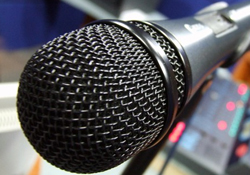
Since my pastor’s voice is recorded pre-EQ, I do some subtle changes to make him easier to listen to. Then I hit it with the compressors.
Currently, I’m using R-Channel from Waves to do both EQ and compression. I will say the R-Channel compressor is one of the more transparent ones I’ve heard; I routinely have it hitting 12+ dB of gain reduction and it’s really tough to hear.
Before I had that plug in, I achieved results almost as good with a combination of ReaEQ and ReaComp—both plug-ins come with Reaper. Most DAWs have basic EQ and compressors built-in, so play with those first before you go spending money on plug-ins.
However, it would be worth it to sign up for Waves mailing list; they often do super deals on individual plug-ins and you can pick up one or two that will rock pretty cheap.
Limiting For The Win
The final step is to use a mastering limiter to really clamp down the dynamic range. I was using JS: LOSER MasterLimiter (included w/ Reaper) for quite a while along with ArdazMaximzer5.
The MasterLimiter allows you to set a maximum level (I went with -.01 dB) that it will allow; it’s a brick-wall limiter so nothing gets over that. It will also do some compression to keep the signal level up.
The Maximizer does some other magic to raise the overall level without driving it over the limit. That combination worked really well, and sounded pretty good once we got it dialed in.

Then I picked up the Waves L3 UltraMaximizer. And that was pretty much that. After setting a few sliders, I can pretty much crank the level like crazy and it sounds amazing. I showed this picture last time, but you can see how little variation in the waveform we have on the rendered file, indicating very little dynamic range. If this were music, I would be upset, but for a speech podcast, it’s about perfect.
Rendering To MP3
Most DAWs can render out to an MP3 file. If you have the option to use the LAME encoder (which you have to do in Audacity or Reaper), use it. It’s a great encoder that produces better-sounding MP3s at lower bitrates than most other encoders.
As I noted earlier, I use the 48 kbps CBR setting, and render in mono. I haven’t had any problems with mono files anywhere, and given that it’s spoken word, stereo unnecessarily doubles the file size.
Experiment
I got to these settings (and all the ones I didn’t tell you about) by doing a lot of experimenting. I intentionally didn’t show you all my EQ, compression and limiting settings because they don’t really matter—they are all specific for our pastor.
If you spend a few hours working on a chunk of the message getting the processing settings right, then tweak your rendering settings, you’ll end up with great results. Then don’t forget to save those settings as presets so you can use them next week.
Recommendations
I’ve mentioned a ton of stuff in this article, but here is a recap of what I recommend for this process. If you have something else that works, by all means, keep using it. If you’re looking for a place to start, consider this list.
Audacity (Free recording/editing software; good basic and free)
Reaper (Full-featured DAW; $60 for non-profit use, incredibly powerful, still easy to use)
Lexicon Alpha (simple 2-track USB audio interface; about $65)
ArdazMaximizer5 (Free maximizing plug-in)
Waves L3 UltraMaximizer (amazing maximizing plug-in; $350, but look for it on sale)
Waves R-Channel (amazing channel strip; $175, but look for it on sale )
Listen
If you want to hear the results of this processing, you can check out the Coast HIlls media page. Listen to the MP3 files, those all have processing similar to what we’re taking about here. Keep in mind, since we have most of this stuff in presets, it takes about 5-10 minutes to edit, process, render, upload and post our podcasts.
Once we did the hard work, the weekly stuff is easy.
Mike Sessler is the Technical Director at Coast Hills Community Church in Aliso Viejo, CA. He has been involved in live production for over 20 years and is the author of the blog Church Tech Arts. He also hosts a weekly podcast called Church Tech Weekly on the TechArtsNetwork.
